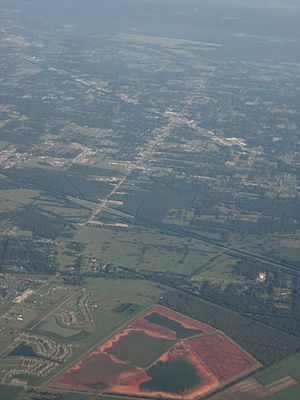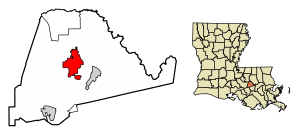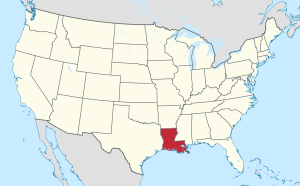Gonzales, Louisiana facts for kids
Quick facts for kids
Gonzales, Louisiana
|
|
|---|---|
| City of Gonzales | |

2009 aerial photo of Gonzales
|
|

Location of Gonzales in Ascension Parish, Louisiana.
|
|

Location of Louisiana in the United States
|
|
| Country | United States |
| State | Louisiana |
| Parish | Ascension |
| Named for | Tee Joe Gonzales |
| Government | |
| • Type | Mayor-council |
| Area | |
| • Total | 9.25 sq mi (23.96 km2) |
| • Land | 9.14 sq mi (23.68 km2) |
| • Water | 0.11 sq mi (0.28 km2) |
| Elevation | 10 ft (3 m) |
| Population
(2023)
|
|
| • Total | 13,059 |
| • Density | 1,337.89/sq mi (516.58/km2) |
| Time zone | UTC-6 (CST) |
| • Summer (DST) | UTC-5 (CDT) |
| ZIP code |
70737
|
| Area code(s) | 225 |
| FIPS code | 22-29850 |
Gonzales is a city in Ascension Parish, Louisiana, in the United States. In 2020, about 12,231 people lived there.
Gonzales is often called the "Jambalaya Capital of the World." It's famous for its yearly Jambalaya Festival, which started in 1968. Stephen "Steve" F. Juneau had the idea for the festival and was its first leader.
Contents
Discovering Gonzales: A Look at Its Past
Early European settlers in the Gonzales area were mostly from France and Spain. They made their homes near the Houma Indians who already lived there.
How Gonzales Grew Over Time
In 1851, Gonzales was a very small settlement with only ten people. A school was opened in 1855 for the children of European families. By 1886, the community had grown, and people chose "Big" José Gonzáles as their sheriff.
José's son, Joseph "Tee-Joe" Gonzales, opened a general store and post office in May 1887. This post office became known as the Gonzales Post Office.
The Railroad and a Name Dispute
The arrival of the railroad helped Gonzales grow a lot. When the Louisiana Railway and Navigation Company (LR&N) built its tracks through the area, the local post office was already named Gonzales.
The railroad company wanted to name their station "Edenborn" after their owner. They also wanted to move the station to a different spot. But local people protested. The Louisiana Railroad Commission ordered the company to keep the station in Gonzales.
The railroad still tried to change the name. So, the residents convinced the Louisiana Legislature to pass a law. This law made sure that railroad stations had to use the same name as the local post offices.
Becoming a Village and Then a City
Gonzales was officially planned out in 1906. It became an official village in 1922, and Joseph Gonzales was elected as its first mayor. The village kept growing, especially after the Airline Highway was built, making travel easier.
In 1952, Governor Earl K. Long declared Gonzales a town. The first Jambalaya Festival happened in 1968. Governor John J. McKeithen celebrated this by calling Gonzales the "Jambalaya Capital of the World."
As more businesses and factories came to the area, Gonzales became a city in 1977.
Gonzales Helps After Hurricane Katrina
In 2005, Gonzales became well-known after Hurricane Katrina caused a lot of damage in other parts of Louisiana. The National Guard and animal rescue groups set up their main base at the fairground in Gonzales.
This base was used for search and rescue missions. It also became a place to care for pets rescued from New Orleans and other areas. Some people were even reunited with their lost pets there.
Exploring Gonzales: Location and Weather
Gonzales is located at 30°13′38″N 90°55′11″W / 30.22722°N 90.91972°W. It covers about 22 square kilometers (about 9 square miles). Most of this area is land, with a small part being water.
Gonzales's Climate and Weather
Gonzales has a subtropical climate. This means it has hot summers and mild winters. The area can experience strong storms throughout the year. Snowfall is very rare here.
Because it's close to the coast, hurricanes can also be a threat. For example, in September 2008, Hurricane Gustav brought strong winds to the area.
People of Gonzales
In 2020, Gonzales had a population of 12,231 people. The city is home to a diverse mix of people from different backgrounds.
National Guard Presence
Gonzales is home to the 922nd Engineer Vertical Construction Company. This group is part of the National Guard. They help people during natural disasters in the United States. They are also ready to go anywhere in the world if needed.
Famous People from Gonzales
- Alicia Morton, an actress
- Cleo Moore, an actress
- Glenn Dorsey, an NFL football player
- Robert Hillary King, a civil rights activist who was part of the Angola Three
Sister Cities
Gonzales has one sister city, which means it has a special friendship with a city in another country:
See also
 In Spanish: Gonzales (Luisiana) para niños
In Spanish: Gonzales (Luisiana) para niños

